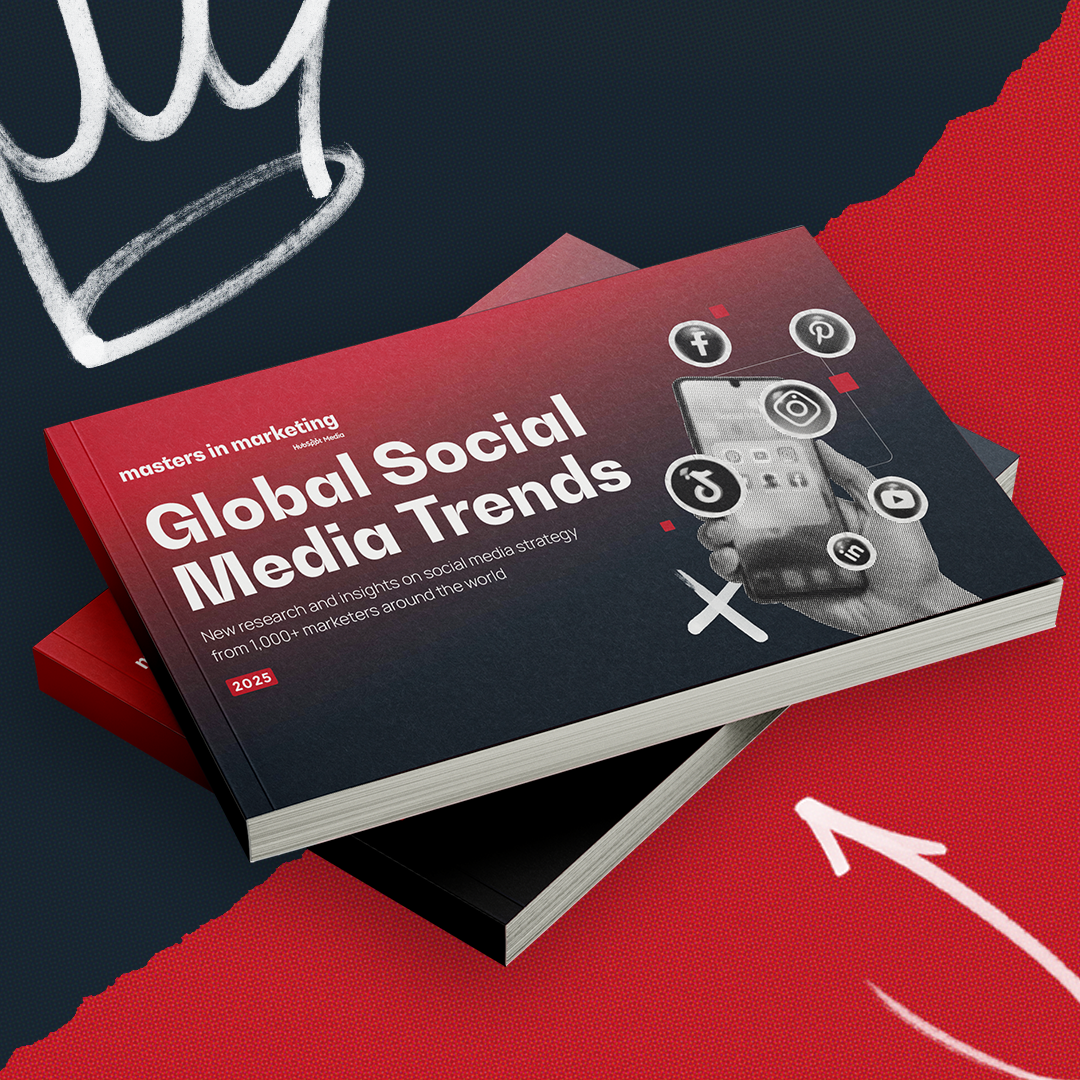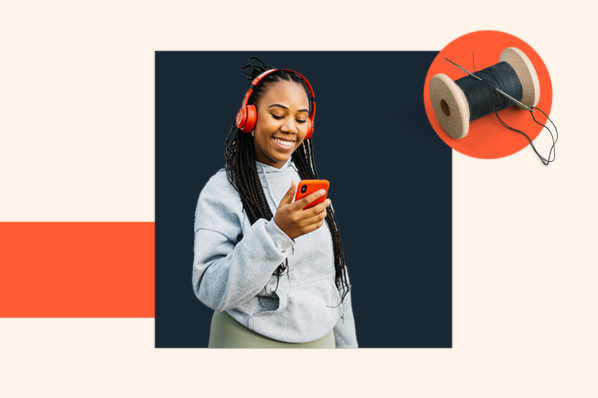If you've ever managed social media for a brand or business, then you know social media is hard. Trends are always changing, and new platforms are constantly cropping up, making it difficult for social media marketers to stay in the know.
Fortunately, HubSpot's most recent survey of over 1,500 social media marketers has shed some light on what trends to expect in 2024, and I will share that information with all of you!
You‘ll get some input from social media experts at G2, Dropbox, Vimeo, Zoom, Aircall, Rakuten Advertising, HubSpot, and more. Let’s get into it. Keep reading, or skip to the section(s) that pertain to you:
Download Now: The 2025 State of Social Media Trends [Free Report]
Chapters
Important Findings & Takeaways for Social Media Marketers
To start, I'll break down some of the biggest trends social media marketers will see in 2024 and how you should shift your strategies accordingly.

The State of Social Media in 2025
Explore the top trends in social media for brands to know and optimize your social strategy.
- AI Content Creation
- Community Building
- Social Media Shopping
- Social Vs. Search Engine
Download Free
All fields are required.

1. Social media communities will be critical for increasing engagement.
According to our most recent survey, an impressive 86% of social media marketers say building an active online community is critical to a successful social media strategy in 2024.
Social media communities provide a digital space for your followers to gather, engage, share ideas, and learn from each other. These spaces provide your audience with even more value.
For example, First Coast News, a news station in Jacksonville, Florida, runs a private Facebook group called First Coast Weather Watchers, and their meteorologists moderate it.
The group allows followers to submit photos and videos of weather or local weather phenomena. The meteorologists often feature the images in their TV reports and shout out the senders.
Group members swap weather stories, learn about their region's climate, and bond over the absurdity of Florida weather.
Through the group, First Coast News became a connector for the community, and the page provides extra value to viewers.
By cultivating social media communities, your brand can be the connector for your prospects and customers. And that's a brand worth investing in.
Back in 2020, HubSpot launched a private Facebook group, Marketer to Marketer. With just 2,000 followers, the group is much smaller than HubSpot's Facebook Page. But it allows for unique conversations.
As former HubSpot Social Media Community Manager Krystal Wu puts it:
“The HubSpot group gives us a more direct way to interact with a more engaged audience. The group content gets preferential placement in followers’ news feeds, whereas our normal Page content is a different content angle. In short, we consider our group followers as our VIPs.”
Wu adds, “The Facebook group also gives our members an outlet for more niched conversations, providing security and privacy to open up about any struggles, techniques, opportunities, or new information they’ve discovered about their industry.”
You're probably wondering, “Why all the Faceook Group mentions? What about other platforms?”
Well, 48% of the marketers we surveyed who build online communities listed Facebook as the most effective for building active communities on social media. Right behind Facebook are YouTube (46%), and Instagram (40%).
.png?width=628&height=419&name=Copy%20of%20Copy%20of%20Linkedin%20-%201104x736%20-%20Horizontal%20Bar%20Graph%20-%20Dark%20(1).png)
If you‘re unsure how to leverage them, you’ll be happy to know both platforms have features that help foster community with users.
YouTube Community tab allows creators to post microblog-like content for their followers to read while not watching videos.
TikTok's features, such as TikTok LIVE, Subscriber-Only Chats, and Subscriber-Only LIVES, help creators connect with their followers exclusively and build a dedicated community.
 (Hear more from Amy Porterfield and other experts by reading How These 6 Social Media Marketers & Creators Built Loyal Brand Communities.)
(Hear more from Amy Porterfield and other experts by reading How These 6 Social Media Marketers & Creators Built Loyal Brand Communities.)
Corresponding Content:
- Are Brands Investing in Social Media Communities in 2023? We Asked 1,200+ Marketers
- How These 6 Social Media Marketers & Creators Built Loyal Brand Communities
2. Watch out, Amazon: Social media is becoming the preferred e-commerce platform for consumers.
When was the last time you bought something on Instagram or TikTok? If you're anything like me, I bet it was recently.
And you're not alone. According to a recent study, nearly 47% of US consumers purchase social media. Furthermore, social is the preferred product discovery platform for consumers aged 18-44.
What is most shocking is that 84% of social media marketers in our survey say consumers will buy products directly in social apps more often than on brands' websites or third-party websites, like Amazon, in 2024.
If you work in the e-commerce or B2C space, you‘ll want to ensure you’ve launched shopping capabilities on your social platforms so your consumers can purchase your products where and when it's most convenient.
The biggest inhibitor to social shopping is a lack of trust — only 17% of consumers say they feel more comfortable purchasing items from a brand's social media than its website.
To build trust with your social audiences, you'll want to:
- Share customer reviews so they can hear about your products or services from real people.
- Work with trusted influencers who can verify that your products are high-quality to their audiences.
- Make sure your social channels don‘t become pure advertisements. Instead, provide value upfront through helpful content and let your consumers decide when they’re ready to buy.
Corresponding Content:
3. Re-sharing the same content across platforms won't fly in 2024.
Since more platforms like TikTok, YouTube, and Instagram are pushing short-form videos, why not save time by reposting the same content as a Reel, YouTube Short, or TikTok video?
But social media platforms don‘t reward re-posted content, and your audiences likely won’t prefer it.
According to our survey, that method goes the way of the dinosaurs in 2024.
Only 19% of social media marketers say they repurpose the same content across their platforms.
Fortunately, that doesn't mean you must make brand-new content for each platform. While 34% of social media marketers say they create brand-new content from scratch for each platform, the majority (47%) say they share similar content across platforms.
The latter explains similar content features and some tweaks to tailor it to the specific platform they're posting on.
In your social media strategy, you can use the same foundational content for each platform as long as you tailor the tone, language, and visuals for each social channel.
As Alison Coleman, Zoom's former Social Media Manager, told me:
“We're excited to focus on each social platform with its dedicated strategy, designing content to engage directly with in-feed. The days of repurposing content are not necessarily over, but tailoring how we tell the same story on different platforms, to different audiences, with a different approach, is something we are excited to prioritize in our content.”
She continues, “Product tips are a core part of our editorial calendar and what our audiences engage with most — but how we share this differs by platform.”

The State of Social Media in 2025
Explore the top trends in social media for brands to know and optimize your social strategy.
- AI Content Creation
- Community Building
- Social Media Shopping
- Social Vs. Search Engine
Download Free
All fields are required.

An example of Coleman's repurposing approach looks something like this:
- Twitter: a thread explaining each action to use the feature and an accompanying gif demoing within the UI, ending with a poll to start a conversation with our community.
- TikTok: short clips filmed on an iPhone, cut together with quick transitions aligned with trending audio, each step displayed with copy on screen and using the TikTok text-to-speech reader or their AI voiceover filters, and a cheeky caption about the tropes of being a corporate worker.
- Instagram: an animated Reel, more polished than the TikTok version, with an animated intro for the series, and then into the UI with VO explaining each step.
- LinkedIn: a carousel with each step as an mp4 or static image, copy to explain the feature, and a comment linking to a relevant blog or training.
- And always adding subtitles or alt-text where applicable!
Coleman adds:
“Taking a per-platform approach will allow us to create and test more no-click content with native platform features so our audience can get the full story without needing to leave the feed. We're excited to be intentional about what our followers go to each platform for and show up how and when they want to see us!”
Click play above, or use this link to access HubSpot YouTube channel's complete social media strategies playlist.
Mat Cruz, former Community Management & Growth Specialist for the HubSpot Social Team, believes reposting can be a good idea, but only when properly executed.
As he puts it:
“When creating content, especially with limited resources, it's important we are using our time and effort efficiently. Still, having a brand in today’s social media landscape often means being on multiple platforms to reach various audience segments.”
He continues, “With wanting to offer all of them content, reposting seems like a fair solution, but like every business decision, the 'right' choice for you comes from weighing your team’s goals against the pros and cons.”
He adds, “In short, reposting content across channels can be a great way to spread valuable information while also lightening the production load, but it requires thoughtful execution to truly resonate and add value.”
If you're considering reposting content, Cruz recommends you consider some of these questions to better inform your decision:
- Does the content you want to repost fit each platform you’re on?
- A simple copy and paste, while being a timesaver, can put a bad taste in an audience’s mouth if the content seems out of place. A tweet may also fit LinkedIn, but not Instagram. You have to take a step back and ask, “Does this message make sense on this platform?”
- Does reposting a piece of content echo value or add noise? Users follow brands to get value from the content they post. If the content doesn’t bring value to the audience, don’t repost it. Social is a noisy place. Don’t add to it for the sake of posting.
- Can reposting be a tool in production, not just publishing?
Cruz says, "If reposting content is going to be something you are incorporating into your strategy, make that decision from the start.
He continues, “The more consideration there is in ideation and production to fit various platform needs, the fewer 'tweaks' you’ll have to make. Think of it similarly to the idea of 'measure twice, cut once'. A piece of copy for LinkedIn reposted on Twitter could have very few tweaks if done well.”
Cruz adds, “Overall, reposting can be a tool to work smarter, not harder. Still, one must be reminded it should always be seen as a tool, not a crutch. In the end, great content can carry itself when created with strong strategy and care.”
Corresponding Content:
4. SEO gives way to social search.
When I hear about a new and interesting brand, I don't start with Google anymore; I start with TikTok or Instagram.
Perusing their social profiles helps me get a clearer and more authentic sense of their mission and products. And I'm not alone — last year, we found that 36% of Gen Z and 22% of millennials preferred to search for brands on social media more often than through search engines.
And social media marketers expect this trend to carry into 2024.
According to our 2024 survey, 87% of social media marketers say consumers will search for brands on social media more often than through search engines.
%20(4).png?width=600&height=300&name=Copy%20of%20Facebook%20Shared%20Link%20-%201200x628%20-%20Percentage%20%2B%20Copy%20-%20Light%20(600%20x%20300%20px)%20(4).png)
Moreover, almost a third of marketers (31%) say optimizing social media accounts for social will become more important in 2024.
This means that while SEO is still a critical component of any marketing strategy, having a social presence is increasingly vital, too.
People use social media nowadays to search for content that is interesting and inspirational, as well as to find people, products/services, and brands.
Here are three top strategies used by social media marketers to optimize your social media accounts for social search:
- Include relevant keywords and hashtags in your social posts
- Include relevant keywords and hashtags in your bio
- Make sure that your username is easily searchable
Corresponding Content:
5. Authentic and high-quality content will win in 2024.
Trust is a deciding factor for consumers when it comes to supporting a brand. Authenticity is one of the best ways to establish trust with consumers.
In our survey, 31% of social media marketers say making authentic and relatable content will become more important in 2024. And other numbers support this statement.
A recent study found that 82% of Gen Z consumers would trust a company more if it used images of real customers in its advertising.
The study also shows that product quality, positive ratings, reviews, and customer service are the top characteristics that establish trust in a brand among Gen Z-ers.
So, to create more authentic branding, incorporate customer testimonials, show real people benefiting from your project, and don‘t make promises you can’t keep to your audience.
And while relatability and authenticity are important, they can't replace high-quality content. When asked which is more important, authentic content or high-quality content, 54% of marketers chose the latter.
Corresponding Content:
- Social Media Platforms Marketers Should Watch in 2023
- Which Social Media Channels are Gaining and Losing Steam? [New Consumer and Platform Data]

The State of Social Media in 2025
Explore the top trends in social media for brands to know and optimize your social strategy.
- AI Content Creation
- Community Building
- Social Media Shopping
- Social Vs. Search Engine
Download Free
All fields are required.

6. 6 PM to 9 PM, along with 12 PM to 3 PM, are the best times to post across social channels.
Every year, we survey social media marketers to figure out what time(s) they find most effective for posting on each social platform — and each year, their answers change slightly.
The best times to post on social media across all industries and platforms are 6 PM to 9 PM and 12 PM to 3 PM. And our survey shows Saturday is the best day to post on most platforms, and Fridays are a close second.
This makes sense. Between 6 PM to 9 PM, many social users are done working and looking for a chance to recharge or wind down with interesting, engaging content.
And anywhere between noon to 3 PM is typically when you hit a lull in your workday. While some might use that as an opportunity to take a walk or eat lunch, others might spend a few minutes scrolling on social before returning to work.
We also collected the best times to post on each individual channel:
- Instagram: 12 PM - 3 PM is the best time to post to the platform, followed by 6 PM - 9 PM and 3 PM - 6 PM. The best day for Instagram is Saturday.
- Facebook: The top three best times to post on Facebook are 12 PM - 3 PM, 9 AM - 12 PM, and 6 PM - 9 PM. The best day is Saturday, followed by Friday.
- X (formerly Twitter): 12 PM - 3 PM is the best time to post on the platform, followed by 3 PM - 6 PM, then 6 PM - 9 PM. The best day is Saturday, followed closely by Friday.
- LinkedIn: 3 PM - 6 PM, 9 AM - 12 PM, and 12 PM - 3 PM. The best day is Monday, followed by Friday and Saturday.
- Pinterest: Between 12 PM and 3 PM. The best day is Saturday.
- YouTube: 6 PM and 9 PM, 12 PM to 3 PM, and 3 PM to 6 PM. Saturdays are the best days to post.
- TikTok: 6 to 9 PM, 3 PM to 6 PM, and 12 to 3 PM. Saturdays are the best days to post.
Of course, I strongly encourage you to use your own social analytics to uncover which days and times got the most engagement on your platform. It's important to test and iterate when it comes to your own personal audience.
Corresponding Content:
- The Best Times to Post on Social Media in 2024 [New Data]
- Twitter is Dead (Kind of): Where X Stands With Consumers [New Data]
Important Findings & Takeaways for Brands
Next, let's dive into the social platforms on which marketing executives can expect to see the highest ROI, plus some big-picture strategy intel (like whether you should hire content creators) to help marketing executives successfully lead a social team.
1. Investing in micro-influencers is more effective than leveraging celebrities.
If you‘re a marketing leader wondering where to invest your budget, time, and resources in 2024, it’s imperative you consider influencer marketing.
Influencer marketing has proven to be one of the most effective strategies for social media marketers. However, I've seen a major shift among social professionals towards micro-influencers over the last couple of years.
In fact, our survey shows that 97% of social media marketers who work with influencers work with smaller creators and influencers with under 100K followers. Only a small percentage of marketers work with celebrity influencers.
Micro-influencers are less expensive, so working with them is easier long-term. Equally importantly, micro-influencers have tight-knit, niche, loyal communities and can be seen as more trustworthy than celebrities.
Social media marketers are placing big bets in 2024 on influencer marketing. In fact, a whopping 84% predict most companies will have a creator or influencer as the face of their brand in 2024, and 55% are increasing their investment in influencer marketing in 2024.
.png?width=563&height=295&name=Copy%20of%20Facebook%20Shared%20Link%20-%201200x628%20-%20Percentage%20%2B%20Copy%20-%20Dark%20(18).png)
Corresponding Content:
2. YouTube can help you achieve the highest ROI out of any platform.
This finding from our survey comes as the biggest surprise to me. In the past, Instagram and Facebook were platforms often named as having the highest ROI.
But in 2024, most social media marketers in our survey (25%) say YouTube provided them with the highest ROI in the past year. YouTube also ties with Instagram when it comes to achieving the highest engagement levels.
So what changed? My takeaway is that YouTube's audience targeting tools are helping marketers tap into their viewers and generate leads.
According to our survey, most social media marketers (27%) say YouTube has the best audience-targeting tools for running paid ads on social media.
No wonder why 45% of social media marketers plan on leveraging YouTube for the first time in 2024 and why 54% plan on increasing their investment in the platform.
Corresponding Content:
- How to Measure Social Media Marketing ROI [with Expert Advice]
- Which Channels See The Most Social Media ROI? [New Data + Expert Tips]

3. It's a good idea to create a customer service strategy on social.
With 70% of social media marketers already offering customer service on social, it's a good idea to consider it for your own strategy in 2024.
Many social users already expect to be able to communicate with brands via social when it comes to their customer service queries.
In the past three months alone, one in five Gen Z, millennial, and Gen X users have contacted a brand through DM for customer service.
You might even consider creating a separate channel for customer service, like Wix did with its Wix Help X account, so users know where to go to get their questions or concerns resolved.
Leveraging social media for customer service can help you meet your customers where they're at on the channels they prefer.
It can also help you minimize the number of requests you get on a given topic: If you can post an answer to a commonly asked question to your entire community through social media, then they don't need to reach out to a representative.
Which leads us to the next question:
Who is answering those DMs? 70% of companies that offer customer service through DMs have a customer service rep respond to the messages — but 60% leave it up to the marketer who is in charge of that platform.
Another 43% use automated tools like chatbots.

I spoke with Julie Fernandez, Aircall's Global Brand Director, to learn how her team approaches social media as a customer service channel.
Fernandez told me, “When it comes to customer support, we see social media platforms as a huge opportunity to proactively communicate with prospects and customers alike, whether it be Twitter, LinkedIn, Instagram, or Facebook.”
In terms of best practices when it comes to customer support on social media, Fernandez advises:
“We carefully monitor our mentions, and if we notice someone needing help or experiencing an outage, we respond as quickly as possible and connect them with our support team directly.”
Furthermore, “We want to ensure they receive the best quality support, and we find that when our team can talk about the issue over the phone, it's far more impactful than going back and forth over social media or using a text-based channel like chat or email.”
She adds, “We also monitor relevant feeds to see organic opportunities for Aircall to share product information, answer product questions, participate in industry conversations, and celebrate our partners.”
She also encourages brands to consider whether creating a community can help them facilitate conversations that help their prospects and customers grow. As she puts it:
“Would it make sense to start a community of your own? If you notice an opportunity to create a shared space, it could pay off in a positive way for your brand and even your product as a whole.”
If you‘re willing to invest in leveraging social media as a customer service platform, you’ll want to ensure you have the resources, time, and tools required to create a streamlined, efficient process for both your customers and your employees.
Corresponding Content:

The State of Social Media in 2025
Explore the top trends in social media for brands to know and optimize your social strategy.
- AI Content Creation
- Community Building
- Social Media Shopping
- Social Vs. Search Engine
Download Free
All fields are required.

Important Findings & Takeaways for Content Creators and Influencers
If you‘re a creator looking to work with a brand in 2024, you’ll want to consider the factors that matter most to those looking to hire.
Most importantly, influencer marketers want to see you can create high-quality social content. Additionally, influencer marketers are concerned with your follower/subscriber count and whether you align with their company's values.
HubSpot's Creator program was launched in 2022, and HubSpot writer Erica Santiago spoke with HubSpot's Head of Creators Partnerships, Alanah Joseph, as well as Brandon Huang, Partnerships Lead for the Creators Program, to learn what they both look for when hiring creators.
One of the biggest factors is your authenticity as a creator.
As Joseph says:
“Authenticity is key. Authenticity builds trust, so when a creator brings their full selves to their content, their audience trusts them. This is important for a brand looking to run advertisements within the creator’s content. If the audience trusts the creator, they will be more likely to trust the creator’s recommendations.”
Additionally, when working with businesses, you'll need to think like a business leader and come prepared with a results-driven approach.
Huang says, “I take a close look at all the quantitative metrics that I can regarding a creator: their reach, their engagement, how consistent they are with posting, and how consistent the results are on the content they create.”
Corresponding Content:
2. The most popular influencer niches include fashion, lifestyle, and fitness/health.
If you're interested in becoming an influencer, it can be helpful to know which industries are most popular for hiring influencers.
Influencer marketers work with influencers/creators in lifestyle/vlog (50%) the most, followed by fashion (48%), beauty (41%), travel (40%), and fitness/health (38%).
Of course, you‘ll want to choose an industry that excites you. If you’re not passionate about the topic at hand, it won‘t resonate well with your audience. Plus, it will be difficult for you to create content long-term on a topic you don’t find interesting.
3. Marketers prefer working with influencers on Instagram compared to other platforms.
It's important to know which platform(s) are most preferred by influencer marketers if you hope to work with businesses in 2024.
As far as platforms, influencer marketers see the highest ROI through Instagram, with YouTube and Facebook tied for #2. These are also the three most popular platforms for influencer marketing.
If you‘re interested in working with brands, then, it’s critical you can demonstrate success on Instagram in particular. Knowing how to create high-quality content that performs well with Instagram's algorithm is vital.
Corresponding Content:
Social Media is Always Changing
Understanding social trends is imperative for your social strategy's success because social media users’ preferences and expectations change — fast.
Hopefully, this page gives you a leg-up on your competition and helps you identify the biggest growth opportunities for your social accounts in 2024.
And if you need more information, click our State of Social Media in 2024 report below.

The State of Social Media in 2025
Explore the top trends in social media for brands to know and optimize your social strategy.
- AI Content Creation
- Community Building
- Social Media Shopping
- Social Vs. Search Engine
Download Free
All fields are required.











![How to Get More Twitter Followers: 10 Expert Tips [Free Kit]](http://53.fs1.hubspotusercontent-na1.net/hubfs/53/00-Blog_Thinkstock_Images/Twitter_Followers_Guide.jpg)